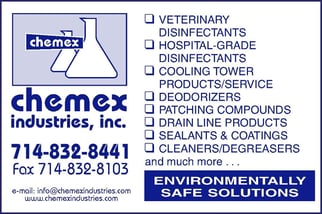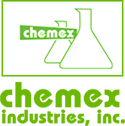95 Flu deaths - H1N1 (Swine Flu) is the prevalent strain this season (January 26, 2014)
Eight Flu deaths have been reported in Orange County, due to the resurgence of the H1N1 virus. 95 people throughout California have also died this season, with 50 new laboratory-confirmed influenza deaths reported, just last week.
Public health officials are urging people to become vaccinated. “So far, from what we’re seeing, it looks like a fairly severe flu season” said Dr. Matt Zahn, the Orange County medical director for epidemiology.
Zahn also said that the most serious illness has hit younger people. The likely reason the strain was less deadly for older adults is because they had greater immunity from previous exposure. (Between 1918 and 1957, all flu viruses that circulated, were in the H1N1 category.
In addition to vaccination, appropriate knowledge in sanitation is critical. Understand how to inhibit the growth of bacteria. The following will outline: How to Clean and Disinfect Your Work Place in Order to Help Slow the Spread of Flu.
Chemex Industries, Inc. offers the “Clean & Healthy Seminar”, to amplify these procedures.
Improper measures lead to cross-contamination, unnecessary infection, waste, additional labor, expense & much more.
Understanding How to Clean and Disinfect Your Work Place, In Order to Help Slow the Spread of Flu
Cleaning and disinfecting are part of a broad approach to preventing infectious diseases in the workplace. To help slow the spread of influenza (flu), the first line of defense is getting vaccinated. Other measures include covering coughs and sneezes, washing hands, and keeping sick people away from others. Below are tips on how to slow the spread of flu, specifically through cleaning and disinfecting.
1. Know the difference between cleaning, disinfecting, and sanitizing
Cleaning removes germs, dirt, and impurities from surfaces or objects. Cleaning works by using soap (or detergent) and water to physically remove germs from surfaces. This process does not necessarily kill germs, but by removing them, it lowers their numbers and the risk of spreading infection.
Disinfecting kills germs on surfaces or objects. Disinfecting works by using chemicals to kill germs on surfaces or touch points. You must be able to pre-clean the area prior to disinfecting, unless you utilize a product that incorporates both actions. By killing and removing germs (pathogens) on a surface, you can further lower the risk of spreading infection.
Sanitizing lowers the number of germs on surfaces or objects to a safe level, as judged by public health standards or requirements. This process works by either cleaning or disinfecting surfaces or objects to lower the risk of spreading infection.
2. Clean and disinfect surfaces and objects that are touched often
Follow your standard procedures, for routine cleaning and disinfecting. Typically, this means daily sanitizing surfaces and objects that are touched often, such as desks, countertops, doorknobs, computer keyboards, hands-on learning items, faucet handles, phones, etc. Many industries also require daily disinfecting these items. Standard procedures often call for disinfecting specific areas of the building, e.g. Bathrooms.
Immediately clean surfaces and objects that are visibly soiled. If surfaces or objects are soiled with body fluids or blood, use gloves and other standard precautions to avoid coming into contact with the fluid. Remove the spill, according to OSHA specifics and then clean and disinfect the surface. (The Chemex “Clean & Healthy Seminar” provides annual certification, as required by OSHA for Bloodborne pathogens)
3. Simply do routine cleaning and disinfecting
It’s important to match your cleaning and disinfecting activities to the types of germs you want to remove or kill. Most studies have shown that the flu virus can live and potentially infect a person for only 2 to 8 hours after being deposited on a surface. Therefore, it is not necessary to close a business to clean or disinfect every surface in the building, to slow the spread of flu. Also, if employees are dismissed because the business cannot function normally (e.g., high absenteeism during a flu outbreak), it is not necessary to do extra cleaning and disinfecting.
Flu viruses are relatively fragile, so standard cleaning and disinfecting practices are sufficient to remove or kill them. Special cleaning and disinfecting processes, including wiping down walls and ceilings, frequently using room air deodorizers, and fumigating, are not necessary or recommended. These processes can irritate eyes, noses, throats, and skin; aggravate asthma; and cause other serious side effects.
4. Clean and disinfect correctly
Always follow label directions on cleaning products and disinfectants. The ideal procedure is to utilize a safe disinfectant, which will clean & disinfect in one-step. “RX-44 ACE” is such a product and does not require a rinse. Read the label to make sure it states that EPA has approved the product for its effectiveness against influenza “A” virus. 
If the surface is visibly dirty, you must repeat the process, using an EPA-registered product that both cleans (removes germs) and disinfects (kills germs). Please be aware that disinfection usually requires the product to remain on the surface for a certain period of time.
Use disinfecting wipes on electronic items that are touched often, such as phones and computers. Pay close attention to the directions for using disinfecting wipes. It may be necessary to use more than one wipe to keep the surface wet for the stated length of contact time. Make sure that the electronics can withstand the use of liquids for cleaning and disinfecting.
Routinely wash eating utensils in a dishwasher or by hand with soap and water. Wash and dry bed sheets, towels, and other linens as you normally do with household laundry soap, according to the fabric labels. Eating utensils, dishes, and linens used by sick persons do not need to be cleaned separately, but they should not be shared unless they've been washed thoroughly. Wash your hands with soap and water after handling soiled dishes and laundry items.
5. Use products safely
Pay close attention to hazard warnings and directions on product labels. Cleaning products and disinfectants often call for the use of gloves or eye protection. For example, gloves should always be worn to protect your hands when working with any bleach solution.
Do not mix cleaners and disinfectants unless the labels indicate it is safe to do so. Combining certain products (such as chlorine bleach and ammonia cleaners) can result in serious injury or death.
Ensure that custodial staff and other employees, who use cleaners and disinfectants, read and understand all instruction labels and understand safe and appropriate use. This might require that instructional materials and training be provided.
6. Handle waste properly
Follow your building’s standard procedures for handling waste, which should include wearing gloves. Place no-touch waste baskets where they are easy to use. Throw disposable items used to clean surfaces and items in the trash immediately after use. Avoid touching used tissues and other waste when emptying waste baskets. Wash your hands with soap and water after emptying waste baskets and touching used tissues and similar waste.
The material listed is also appropriate for Cleaning & Disinfecting Schools & Classrooms, as outlined by CDC.


